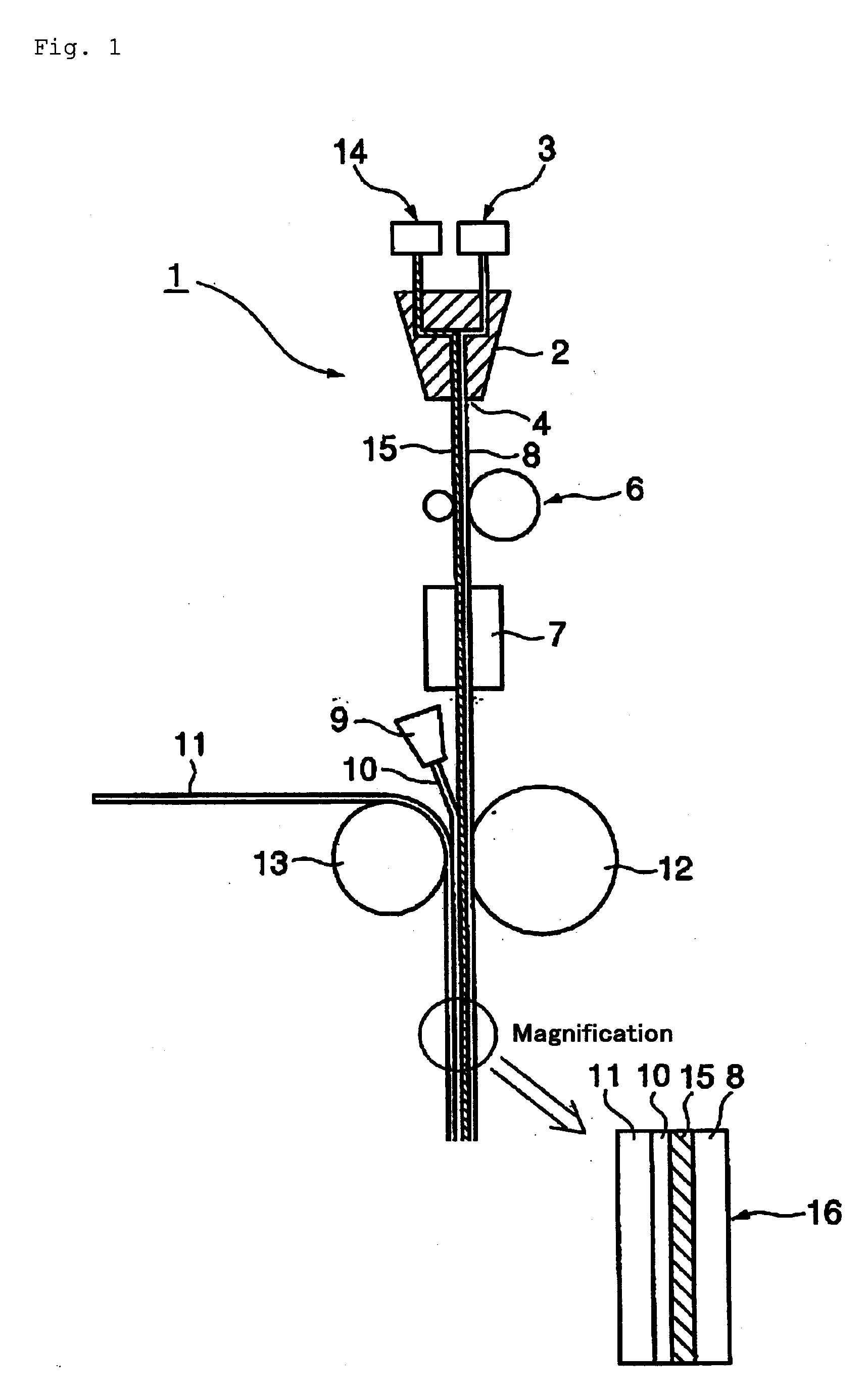Thermal transfer image-receiving sheet and method for producing the same
- Summary
- Abstract
- Description
- Claims
- Application Information
AI Technical Summary
Benefits of technology
Problems solved by technology
Method used
Image
Examples
experimental example 1
[0118]A material of a receiving layer and a material of an insulating layer, consisting of the following composition, respectively, were melt-coextruded in thicknesses of 36 μm and 360 μm, respectively, and the resulting coextruded film was stretched by 9 times in terms of a material area with a biaxial stretching machine manufactured by Toyo Seiki Seisaku-sho, Ltd., and the stretched film was subjected to heat setting at 240° C. while chucking the film in both directions to obtain a receiving layer / insulating layer film of 44 μm in thickness having voids which are minute cavities in the insulating layer.
(Material of Receiving Layer)
[0119]Polyester resin (SI-173, produced by Toyobo Co., Ltd.)
[0120]100 parts
Silicone oil (X-22-3939A, produced by Shin-Etsu Chemical Co., Ltd.) 1 part
(Material of Insulating Layer)
[0121]Polyester resin (SI-173, produced by Toyobo Co., Ltd.)
[0122]80 parts
Calcium carbonate (PO-150-B-10, produced by SHIRAISHI CALCIUM KAISHA, Ltd.) 20 parts
[0123]A backside la...
experimental example 2
[0127]A material of a receiving layer, a material of an insulating layer and a good adhesive layer, consisting of the following composition, respectively, were melt-coextruded in thicknesses of 36 μm, 360 μm and 36 μm, respectively, and the resulting coextruded film was stretched by 9 times in terms of a material area with a biaxial stretching machine manufactured by Toyo Seiki Seisaku-sho, Ltd. to obtain a receiving layer / insulating layer / good adhesive layer film of 48 μm in thickness having voids which are minute cavities in the insulating layer.
(Material of Receiving Layer)
[0128]Polyester resin (SI-173, produced by Toyobo Co., Ltd.)
[0129]100 parts
Silicone oil (X-22-3939A, produced by Shin-Etsu Chemical Co., Ltd.) 1 part
(Material of Insulating Layer)
[0130]Polyester resin (SI-173, produced by Toyobo Co., Ltd.)
[0131]80 parts
Calcium carbonate (PO-150-B-10, produced by SHIRAISHI CALCIUM KAISHA, Ltd.) 20 parts
(Material of Good Adhesive Layer)
[0132]Polyester resin (SI-173, produced by T...
experimental example 3
[0135]A thermal transfer image-receiving sheet of Experimental Example 3 was prepared by following the same procedure as in Experimental Example 1 except for changing the material of the insulating layer of Experimental Example 1 to the following composition.
(Material of Insulating Layer)
[0136]Polyester resin (SI-173, produced by Toyobo Co., Ltd.)
[0137]80 parts
Silicone filler (KMP-590, produced by Shin-Etsu Chemical Co., Ltd.) 20 parts
PUM
| Property | Measurement | Unit |
|---|---|---|
| Fraction | aaaaa | aaaaa |
| Ratio | aaaaa | aaaaa |
| Thermal properties | aaaaa | aaaaa |
Abstract
Description
Claims
Application Information
 Login to View More
Login to View More - R&D
- Intellectual Property
- Life Sciences
- Materials
- Tech Scout
- Unparalleled Data Quality
- Higher Quality Content
- 60% Fewer Hallucinations
Browse by: Latest US Patents, China's latest patents, Technical Efficacy Thesaurus, Application Domain, Technology Topic, Popular Technical Reports.
© 2025 PatSnap. All rights reserved.Legal|Privacy policy|Modern Slavery Act Transparency Statement|Sitemap|About US| Contact US: help@patsnap.com


